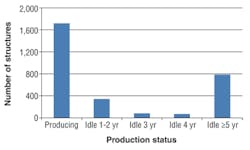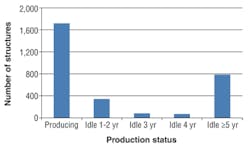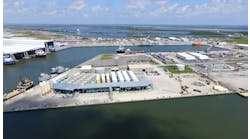New lock keeps bayou cargo flowing; LA 1 again seeks funding
A waterway that some contend is as vital to the offshore as its more popularized overland counterpart received a major boost late last year with the long-awaited opening of a lock engineered to keep rig-bound cargo moving.
The November opening of the Lean Theriot Lock on widely traveled Bayou Lafourche is heralded as a high point for barge captains who often found themselves grounded, sometimes for days after a storm had passed over the southern coast of Louisiana. Before the opening of the lock, the area relied solely on the bayou’s network of floodgates. While effective in heading off flooding, the gates prevented vessels from transporting needed supplies and equipment offshore, says Windell Curole, general manager of the South Lafourche Levee District. The district’s primary responsibility is to maintain the ring levy flood prevention system. The district has been working to build the lock for the past 15 years.
Meanwhile, at press time the LA 1 Coalition was heading back to the drawing board after being denied a $300-million federal grant that would help fund the final 8.3-mi (13-km) segment of the new elevated LA 1 highway system. The so-called Transportation Investment Generating Economic Recovery (TIGER) grant would have been used to complete the elevated highway between Golden Meadow and Leeville, where it would tie into the elevated Tony Doucet Bridge that opened last July.
Coalition Executive Director Henri Boulet says the group knew up front that the competition it faced in getting a share of the total $1.5-billion the US Department of Transportation (DOT) is earmarking for highway and bridge projects, public transportation proposals and port projects would fierce.
“The LA 1 Coalition is disappointed by the fact our well-drafted and compelling TIGER grant application was not selected. In reviewing the list of projects that did receive funding, it is clear to me that a decision was made by the Department of Transportation to spread the money across the country versus focusing on large significant projects such as LA 1. We had hoped that the majority of funds would be directed to large-scale projects of national importance like ours. The Coalition’s work is far from over, and we are looking at additional funding opportunities being proposed by Congress in the coming months,” he says.
The remaining eight-mi (13-km) stretch remains the only unfunded portion of the highway that is engineered to keep cargo and production flowing in and out of the port during storms. This past July, the $161-million elevated toll way over Bayou Lafourche opened to replace the old and decrepit Leeville bridge that was considered the “weakest link” in the oft-flooded and badly damaged LA 1 highway. The old bridge has since been demolished.
Curole and the levee commission definitely have experience when it comes to acquiring funding. Since conceiving the idea for a lock in 1995, the commissioners of the South Lafourche Levee District had to face more than their share of frustration when it comes to funding. What’s more, the original price tag for the lock was $7 million, but the final bill came in at $25 million, Curole says, thanks in no small part to Hurricane Katrina in 2005 that sent construction costs soaring.
While no precise numbers are available, Chett Chiasson, executive director of the Greater Lafourche Port Commission, says “hundreds” of barges and other vessels traverse the bayou monthly, delivering equipment and supplies offshore. Ultimately constructed with a combination of state and federal funds, the uniquely engineered lock, which was fabricated in Morgan City, Louisiana, and floated into place, is designed to keep that traffic moving, which was not the case with the floodgates.
“The floodgates would be closed two days prior to a storm and after the storm passed a low-pressure system could remain over the area for a week. The gates would have to remain closed until all the threat of flooding had passed. We’ve had boats with millions of dollars worth of cargo trapped and unable to navigate the bayou for days after a storm had passed,” Curole says.
Days after its unveiling, the lock received its first big test when in late November Ida became the latest forming hurricane in history. The lock passed the test with flying colors, Curole says.





